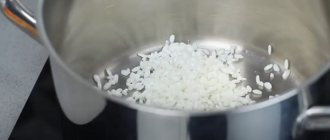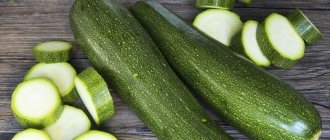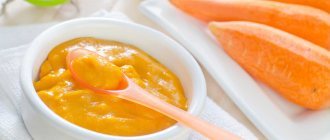White cabbage is a tasty and healthy vegetable. This product contains various minerals and vitamins.
Vegetables should be included in a child’s diet from a certain age. For newborns and infants, this product is difficult for the stomach and intestines.
It is important for parents to know when to give their child white cabbage.
Useful properties of white cabbage
It becomes not enough for a growing baby to eat only mother's milk. For full development, from a certain point, complementary feeding becomes simply necessary and even inevitable. Many mothers are interested in where it is better to start, in what form to give and much more. Thus, most doctors do not recommend introducing crumbs of fruit into your baby’s diet first, since the baby will most likely like them more than vegetables.
White cabbage is a very common vegetable grown in our country. However, its popularity is not justified by this. The fact is that the product contains a lot of useful substances:
- Contains phosphorus, potassium, chlorine, sulfur, calcium.
- Contains phytoncides.
- Contains the following vitamins: B, E, A, U, as well as folic and tartonic acid.
In addition to the high content of substances beneficial to the human body, white cabbage has other advantages:
- It is considered a hypoallergenic food product.
- It is low in calories. In particular, this product is recommended by pediatricians as the first complementary food for babies who have problems with excess weight.
- It has a beneficial effect on the smooth muscles of the intestine and on the entire gastrointestinal tract in general.
- Thanks to cabbage juice, which is contained in the fresh product, the enzymes necessary for the development of the child’s body are produced.
However, it is worth considering that this product may have other consequences that are not entirely pleasant. We suggest considering some properties of the vegetable that can cause negative consequences in a child when taken:
- This vegetable is distinguished by the presence of coarse fiber, which in the future can cause irritation of the baby’s stomach and intestinal mucosa.
- After eating cabbage, a child may experience pain in the tummy. In such a case, you should immediately stop giving this product to your child.
- It is this product that can lead to excessive gas formation (flatulence) in a baby.
- Problems with stool cannot be ruled out (if we are talking about a child, then most often gastrointestinal disorders manifest themselves in the form of diarrhea).
- It is very rare, but there are cases when cabbage can trigger an allergic reaction.
Composition, benefits and harm
White cabbage contains vitamins C and E, K and D, group B and rare vitamin U. Little is said about the latter, but with regular consumption it treats gastritis and ulcers, increases intestinal tone and normalizes liver function.
Vitamin D is especially useful for children, as it strengthens bones and prevents rickets. Since this substance is produced by the sun's rays, in regions with little sun, children do not receive enough of this important element.
Cabbage contains an increased concentration of ascorbic acid, which is responsible for immunity and good mood. This vegetable retains vitamin C for up to eight months, which only citrus fruits can boast of.
Cabbage performs the following beneficial functions and properties:
- Accelerates growth and restores cells, forms hematopoiesis;
- Has a beneficial effect on the functioning of the liver, kidneys and other internal organs;
- Normalizes metabolism, the functioning of digestion and intestines, eliminates constipation;
- Heals wounds and improves skin condition;
- Strengthens bones and teeth, heart and blood vessels;
- Cleanses the body of toxins and foreign proteins, waste and excess fluid, relieves swelling;
- Strengthens and supports the immune system, tones the body;
- Restores strength, gives vigor and energy, eliminates fatigue and improves mood;
- Calms and strengthens nerve cells, relieves stress and pain;
- Has a beneficial effect on the condition of the skin of the lips, eliminates cracks on the lips;
- Improves the absorption of iron, proteins and fats in the body;
- Normalizes cholesterol levels and protects against heart disease;
- Stimulates brain function;
- Useful for gastritis, gout and cholelithiasis;
- Increases appetite, but does not contribute to excess weight gain.
Cabbage is low in starch, sucrose and calories. Therefore, it is recommended for diabetes and increased weight. The vegetable is often included in the diet menu. However, it can also cause negative reactions, especially when eaten raw or fried.
This product is absorbed slowly and slowly, increases gas formation and worsens stool. May cause allergies and poisoning, pain and discomfort in the abdomen. To avoid a negative reaction, it is important to properly administer and prepare the product for your baby. Next, we will find out at what age a child can be given white cabbage.
When can vegetables be introduced into complementary foods?
Many mothers ask the same question: when can cabbage be introduced into their child’s diet? Some parents are sure that this product should be introduced into complementary foods almost first, however, in reality, everything is different.
So, basically, white cabbage is introduced from 7-9 months. They don't start complementary feeding with her. Before the product there are vegetables such as pumpkin, zucchini, carrots, potatoes, broccoli. However, white cabbage should be used as an additive to other purees.
As a separate dish, fresh vegetables can be prepared for a child starting from 3 years old, and all because the product must be thoroughly chewed when consumed, and a child up to this age cannot do this properly.
It is worth noting that the stalk of the vegetable should not be eaten as it is toxic. The fact is that it is in this part of the product that harmful substances are concentrated, which people sometimes use during cultivation.
Video on the topic
Dr. Komarovsky on the basic rules for introducing complementary foods:
Thus, white cabbage contains many substances that are beneficial for the child’s body. But it is better to introduce it into the diet from 8-12 months, after becoming familiar with other vegetables.
Cabbage contains a lot of fiber, so it can cause flatulence and indigestion. The product should be offered to children in stewed, boiled or steamed form. You can make soups, casseroles, and cabbage rolls from the vegetable.
White cabbage in a child's diet
If complementary feeding occurs for the first time, white cabbage should be given exclusively not as an independent dish, but in combination with other purees, and it is desirable that such a dish be multi-component. More often, cabbage is mixed with carrots, potatoes and even other types of cabbage.
If the child is already one year old, you can offer stewed cabbage, steamed meatballs, vegetable stew, cabbage rolls. Children over 3 years old can safely prepare a fresh salad or casserole.
The baby is able to identify a new product in his diet, so the parent needs to observe for some time how the baby reacts to the new product. When the child perfectly assimilates the offered food the first time, and there is no negative reaction, especially from the gastrointestinal tract, you can safely increase the dosage of a particular product at the next meal.
In the event that a negative reaction to a new dish nevertheless occurs, it is worth suspending such complementary feeding and eliminating white cabbage from the child’s diet.
You can postpone preparing the product for some time, therefore, if a negative reaction to the product occurs, it is not at all recommended to conclude that it should no longer be offered to the baby.
Healthy recipes with cabbage
You can prepare various healthy and tasty dishes from white cabbage. Recipes for children are given in the table below.
Fresh cabbage soup
| Name of the dish | Ingredients | Cooking method | Notes |
| Cabbage soup |
| Boil the chicken. In this case, you should change the water twice after boiling (in order to remove all bad substances and reduce the percentage of fat). Chop the cabbage finely and add to the broth. After boiling, add carrots, potatoes and onions to the soup. Add olive oil. Cook until the potatoes are ready. | The recipe is suitable for children 1-1.5 years old. For older children, you can prepare cabbage soup with the addition of bell peppers, tomatoes and bay leaves. |
| Lazy cabbage rolls |
| Peel the carrots and onions, chop and simmer. Pass the cabbage and meat through a meat grinder. Mix vegetables with minced meat. Add rice, egg. Add a little salt. Place the container with the mixture in the refrigerator for an hour. Peel the tomato and chop. Combine with sour cream. Form minced meat into balls and place on a baking sheet. Pour in sour cream and tomato sauce. Place in the oven for 40 minutes. The dish should be baked at 180 degrees | |
| Braised cabbage |
| Finely chop the cabbage and place in the frying pan. Pour in water and milk. Cover the vessel with a lid. Simmer until done. Then add a little salt and keep on fire for a couple more minutes. At the end add butter. | The dish can be served with mashed potatoes or rice porridge. Suitable for babies 8-10 months |
Basic cooking rules
If the baby is not yet a year old, then you should not count on giving white cabbage in its pure form. As already mentioned, white cabbage should be given in symbiosis with other vegetables, while you need to take into account some cooking rules:
- To begin with, you should take no more than a third of a teaspoon of the vegetable.
- The cabbage must be thoroughly cooked.
- The product must be thoroughly rubbed until a paste-like mass emerges.
- If the child is one year old, the cabbage can be chopped into small cubes and stewed or steamed in this form.
At what age can it be introduced into a baby’s diet?
When you can give your child white cabbage will depend on the age at which the parents started feeding the baby and what foods the baby is already familiar with.
Pediatricians recommend giving white cabbage after including cauliflower and broccoli in the diet. The last two types of products are easily digestible, do not provoke allergies, and therefore are suitable for baby food.
White cabbage is usually given to infants from the age of eight months, provided that the baby does not suffer from increased gas formation. The vegetable should be offered in chopped and boiled form. It is better to use it as an ingredient in some dish. The first time you should offer your baby half a teaspoon of cabbage puree. After this, you need to observe changes in the baby’s well-being.
If there are signs of food allergies or colic, then you should wait before introducing this product into your diet. If the child feels normal, then you can give him white cabbage in larger quantities. Fried and raw, the product can be included in the diet after three years.
White cabbage puree
Pediatrician Komarovsky E.O notes that if a child develops colic, upset stool, or worsened appetite while eating cabbage, then it is worth giving up this vegetable for up to a year.
Baby puree recipe
Doctors do not recommend feeding white cabbage to infants. As mentioned above, this vegetable, in principle, is not advisable for consumption by children under 1 year of age, especially in its pure form. This is due to the fact that the product contains a large amount of coarse fiber, and this will lead to abdominal pain in the baby.
The best option would be to make puree for your child not from cabbage alone, but in symbiosis with other vegetables. We offer a similar recipe.
To prepare a puree that would include white cabbage, you can take any vegetables. It could be potatoes, zucchini, carrots, pumpkin. By the way, products need to be taken in small quantities.
Prepared products are peeled and cut into small pieces. The prepared vegetables are placed in a pan of water and boiled for 20-25 minutes, after which they should be mashed with a fork or chopped in a blender. Believe me, in this form the baby will definitely not refuse to try such a healthy dish!
Cooking recipes for children
White cabbage puree is perfect for a first acquaintance. It's easy to prepare:
- Clean the head of cabbage from the top leaves and wash.
- Cut into small thin strips.
- Place the cut pieces in an enamel bowl and fill them with water.
- Cover the pan with a lid and leave the vegetable to cook on the stove over low heat (you can use a slow cooker or double boiler instead of a stove). If the cabbage is purchased, drain the first broth.
- When the vegetable is cooked, discard it in a colander.
- Using a blender or sieve, grind the boiled leaves. Add a few tablespoons of cabbage broth or boiled water to the resulting puree to achieve the desired consistency.
- Now you can give food to the child.
Complementary feeding with white cabbage causes disappointment for many mothers, since it often causes increased gas formation in the baby. But the beneficial properties of the vegetable do not allow us to completely reject this product. In this situation, it is common sense to combine cabbage with other foods (but only after the baby has successfully adapted to them). Various combined vegetable purees and soups are very healthy for the child and are also safe.
Puree soup (from 7 months of age)
Ingredients: potatoes - 1 piece, carrots - 0.5 pieces, zucchini - 100 grams, white cabbage - 100 grams, pumpkin - 100 grams, water.
Preparation: Peel, wash the vegetables and chop them. Place the chopped vegetables in a saucepan and add enough water to cover them. Place the pan on the stove. After boiling, vegetables should be cooked for 20-30 minutes (until ready). Remove the vegetables from the water and puree them in a blender. If necessary, add a little vegetable broth to the puree.
Video recipe for vegetable puree (from 7 months of age)
Video recipe for another vegetable puree:
Tips for choosing
Products that go into food must be carefully chosen, especially when it comes to children. There are several tips for choosing white cabbage, which we have selected for your reference. So the product should:
- be free from cracks or wrinkled areas;
- have a uniform color;
- distinguished by sheets tightly adjacent to each other;
- stand out with a tight head of cabbage;
- be hard to the touch.
In any case, if cabbage looks unsightly, then you shouldn’t buy it, especially since now there is a wide choice of products.
How to give cabbage
The first time you give cabbage only in combination with other multi-component purees (no more than a third of a teaspoon is added). As a result, it must be boiled and well pureed into a paste (most often a blender is used).
If the little one is more than one year old, finely chopped cabbage can be stewed or steamed. The rule of grinding vegetables into puree is mandatory.
The baby is able to identify a new product. Therefore, you will have to observe the child’s reaction for some time. If the toddler has fully accepted the new product, then next time it is allowed to slightly increase its dosage in the usual puree.
When any negative reactions appear (from allergic to simple reluctance of the baby to consume a new product), it is advisable to postpone such complementary foods until better times and completely eliminate the introduction of cabbage into purees as one of the components for some period.
For children, it is necessary to choose only high-quality vegetable products.
- contain cracks;
- have a wrinkled appearance (or dented areas);
- characterized by the presence of sheets peeling off from each other;
- have sheets of thick structure;
- differ in heterogeneous coloring;
- airy, “cotton-like” and light in weight (good fresh heads of cabbage are always tight, strong and hard to the touch).
At the age of 5-6 months, the child’s body can already allow for variety in nutrition. It is at this time that the introduction of complementary foods into the child’s diet begins, since milk or formula cannot fully ensure the further development of the infant’s body. The very first dishes for babies are vegetable purees: zucchini, cauliflower, broccoli, and white cabbage. So, let's try to figure out when you can give your child white cabbage.
Stewed cabbage for children
How to cook cabbage for a child so that it is healthy and tasty? The best option is stewed cabbage. This dish is suitable for children over one year old. In addition, you can add other vegetables and meat to the stewed cabbage leaves.
To prepare the dish you will need:
- Cabbage leaves;
- butter;
- water or chicken broth.
The amount of ingredients is calculated individually. It is not recommended to give small children food from the refrigerator. Therefore, you don't need to cook a lot.
The first step is to wash and finely chop the vegetable. There is no need to leave the stalk. Heat butter (2-3 teaspoons) in a frying pan. Next add the shredded cabbage leaves. Then simmer under a closed lid, adding a little chicken broth or water.
Cooking methods
The covering upper leaves, stalks and stem bases should be cut off before cooking. They contain a lot of contaminants and nitrates.
The best way to prepare it: steam a piece of cabbage or in a pressure cooker, then grind it in a blender. It is not advisable to add sugar and salt. To improve the taste, you can add a little butter to the puree.
White cabbage should be given to a child under 1.5 years old separately or mixed with other types of vegetables: zucchini, carrots, pumpkin.
This will protect the digestive tract from unnecessary stress. It is recommended to include cabbage in your diet at least once a week. If the child likes it, 2–4 times. The first half of the day or afternoon snack is the preferred time. It is better not to put cabbage aside for dinner so that it has time to digest.
For older kids, you can give cabbage puree with meat, cottage cheese, buckwheat porridge, and prepare vegetable or chicken soups. When adding vegetables to first courses, they must be finely chopped or crushed until creamy.
How to cook cabbage for a 3-4 year old child depends on his preferences. At this age, it can be eaten raw: in salads with apples, tomatoes, and herbs. We recommend casseroles with rice or semolina, eggs, and pureed meat.
Fried or sauerkraut, as well as complex dishes based on it: borscht, zrazy, cabbage rolls are recommended no earlier than 6 years. At this age, the gastrointestinal tract is ready to digest heavier foods.
What are the benefits of cauliflower?
This vegetable has many beneficial properties. In addition to vitamins and microelements, it contains carbohydrates and fatty acids. In addition, cauliflower almost never causes allergies, which is extremely important for an infant.
Cauliflower can normalize the functioning of the intestines, remove toxins and other harmful substances from the body.
Iron deficiency anemia occurs quite often in infants. Cauliflower contains ten times more iron than other vegetables: peppers, green peas, zucchini and eggplants. Due to this, cauliflower can be called an excellent preventive and therapeutic remedy for anemia. And its vitamin C content is twice as high as white cabbage.
The sensitive gastrointestinal tract of an infant will easily tolerate a new product that does not irritate the mucous membrane. The vegetable is well digested and absorbed.
Cauliflower contains rare vitamin U, which helps the gastric mucosa recover and normalizes the acidity of gastric juice.
Another type of cabbage is Savoy
Savoy cabbage differs from white cabbage in having corrugated, wrinkled leaves of different shades of green.
In Western European countries, France and Italy, where Savoy cabbage is common, it is called Milanese. Savoy cabbage tastes like cauliflower.
Raw cabbage is used to prepare salads, it is added to soups and used to prepare various vegetable dishes: casseroles, stews, cabbage rolls. But this cabbage is not suitable for pickling.
This vegetable is a very valuable dietary product. In terms of nutritional and taste properties, it is superior to white cabbage: it is more tender and contains less fiber.
Nature does not deprive Savoy cabbage of vitamins: it contains a lot of vitamins B, A, and ascorbic acid. Among the mineral substances in Savoy cabbage, you can find sulfur, iron, nitrogenous substances, half of which are easily digestible proteins. In terms of protein content, this type of cabbage is a champion among its cabbage counterparts.
Savoy cabbage is necessary for older people. It contains a lot of not only phosphorus and calcium, but also potassium, which is necessary for the functioning of the heart muscle, which predominates in the leaves of this type of cabbage.
You can grow Savoy cabbage in the same way as white cabbage. When purchasing, you need to pay attention to the leaves: they should not be spoiled.
Is it possible to freeze cabbage?
If the first complementary feeding occurs in the winter or early spring months, then it is better to take care of the vegetable diet in advance and freeze the products. You can freeze cabbage either fresh or after blanching:
- Freezing fresh vegetables. Rinse fresh vegetables well under running water and leave for 20 minutes in warm salt water to disinfect and preserve color. Then rinse the vegetables again, dry with paper towels and place in portions in plastic containers or bags.
- Blanching. Place the washed inflorescences in boiling unsalted water for 5 minutes. Then remove the vegetables and immediately transfer them to ice water. You also need to keep the cabbage in cold water for 5 minutes. Afterwards, you need to dry the inflorescences and place them in portions in bags.
Vegetables frozen in this way can be stored for up to 6 months without losing their beneficial properties. Vegetables from the freezer are prepared for the baby in the same way as fresh ones - the inflorescences are boiled until soft and then ground.
To read: Is it possible to drink Ivan tea during pregnancy in the early and late stages or not?
Cauliflower puree is the right choice for complementary feeding. Vegetables teach your baby to eat healthy foods and provide him with the necessary vitamins. Mothers who feed their infants vegetables do not face the problem of how to feed their already matured child “healthy foods.”
READ ALSO: How to prepare pumpkin puree for babies?
From what months can you give your baby dishes with cabbage?
Before introducing a new product to the baby, the mother should know not only when to start giving white cabbage to the child, but also in what form to add this vegetable to his diet.
When to introduce white cabbage into baby food - the child is “introduced” to the product up to a year, after he tries puree with carrots, zucchini, cauliflower, potatoes and pumpkin. Pediatricians recommend introducing it no earlier than 8-9 months of age for a breastfed baby and 1-2 months earlier for a formula-fed baby.
Basic rules for introducing the product into complementary foods:
- For the first time, the baby is given a minimum portion of a vegetable - no more than half a teaspoon. If the intake is well tolerated and there are no digestive problems, the portion of cabbage in complementary foods is gradually increased.
- It is best to prepare the vegetable and give it to the child in the morning, and then observe the child’s body’s reaction to the new complementary foods throughout the day.
- For the first feeding, the baby is given only cabbage puree. For an older child, white cabbage can be combined with other vegetables - potatoes, carrots, zucchini.
- After 1 year, babies are allowed to give stewed cabbage, as well as vegetables in soup, salad, vegetable stew or steamed cabbage rolls.
- Sauerkraut can be given to children after three years of age and in minimal quantities.
Fresh vegetables are allowed to be used for baby food only after reaching 3 years of age and provided that the child does not have diseases of the digestive system.
- What are the benefits of white cabbage?
- When and how to include in complementary foods
- Cooking methods
- How to choose cabbage for a child
Some parents believe that white cabbage is harmful to children due to its coarse fiber content and do not introduce it into complementary foods, replacing it with other types of vegetables. But this approach is justified only in the presence of digestive disorders or intolerance to the product. And it is useful for healthy babies.











